|
za 2004 god.
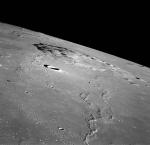 Volcanic Rump
Volcanic Rump
14.02.2004 | Lunnoe foto dnya
We think of the Apollo missions as being near equatorial - and the landing sites were - but the sinusoidal orbit of the Command Modules took them as much as 25 degrees from the equator.
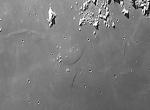 Happy Valentine Dome Day
Happy Valentine Dome Day
13.02.2004 | Lunnoe foto dnya
Here is a lunar Valentine Day's card courtesy of KC Pau. Valentine's Day, named for a martyred Roman saint (who sent his jailer's daughter a note signed, "From your Valentine") is associated with hearts.
 Copernicus in Color
Copernicus in Color
12.02.2004 | Lunnoe foto dnya
Robotic spacecraft have made two major contributions to lunar imaging. From the mid-1960s thru the early 1970s, high resolution images were obtained by Lunar Orbiter and Apollo spacecraft - this is still the highest resolution coverage available for the Moon. During the 1990s, global multi-spectral coverage was acquired by Galileo, Clementine and Lunar Prospector.
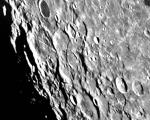 Happy Birthday, Darwin!
Happy Birthday, Darwin!
11.02.2004 | Lunnoe foto dnya
Charles Darwin, who ranks with Newton and Einstein as one of the world's greatest scientists, was born on this date 195 years ago at Shrewsbury, England. Unlike Darwin's ideas, which remain robust, the lunar crater Darwin has seen better days.
 I Drew a Lunar Map So I Get to Add Names!
I Drew a Lunar Map So I Get to Add Names!
10.02.2004 | Lunnoe foto dnya
Somewhere, a decade or so ago, I picked up a single page from an old Pacific Discovery magazine that contained this map. Its obviously a hand drawn one, with a lot of effort spent depicting hundreds of craters with many slightly jiggly lines representing the maria.
 Lunar Pyroclastic Deposits
Lunar Pyroclastic Deposits
9.02.2004 | Lunnoe foto dnya
Lunar volcanism is best represented by the massive lava flow piles - or maria - filling impact basins. But the Moon also had other styles of volcanic activity including explosive or pyroclastic eruptions. Pyroclastic is the two dollar (2 Euro?) word for fragmental rocks thrown out of erupting volcanoes.
 Seeing Double: Pythagoras
Seeing Double: Pythagoras
8.02.2004 | Lunnoe foto dnya
From Galileo in 1610 through the early 20th century, the only way to depict the lunar surface was by peering through a telescope and drawing what was seen. Lunar drawings were affected by each observer's telescope and eyepieces, seeing, visual acuity and artistic abilities.
 Crazy Quilt Imbrium
Crazy Quilt Imbrium
7.02.2004 | Lunnoe foto dnya
Are you lost looking at this image? Its our Moon, but as seen through very odd spectral glasses. To help get your bearings I've labeled some craters: A = Aristarchus, C = Copernicus, H = Harpalus, P = Plato; you can figure out the rest!
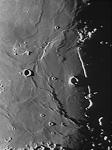 Crumpled Sheets of Lava
Crumpled Sheets of Lava
6.02.2004 | Lunnoe foto dnya
Crumpled sheets on a bed result from movement of a thin surface layer (the sheet) due to underlying motion (the restless sleeper). KC Pau's low sun view of eastern Mare Nubium looks like a messy lava sheet where most of the movement may have been vertical.
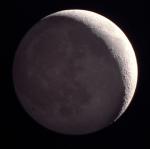 New and Old All Together
New and Old All Together
5.02.2004 | Lunnoe foto dnya
The crescent Moon is one of the glories of the solar system. The bright, sun-lit portion of the Moon doesn't yet overwhelm the Earth-lit, gibbous part. In Alan Friedman's remarkable composite rendition of this classic scene there is a strong three-dimensionality - you can almost feel the curvature of the surface.

